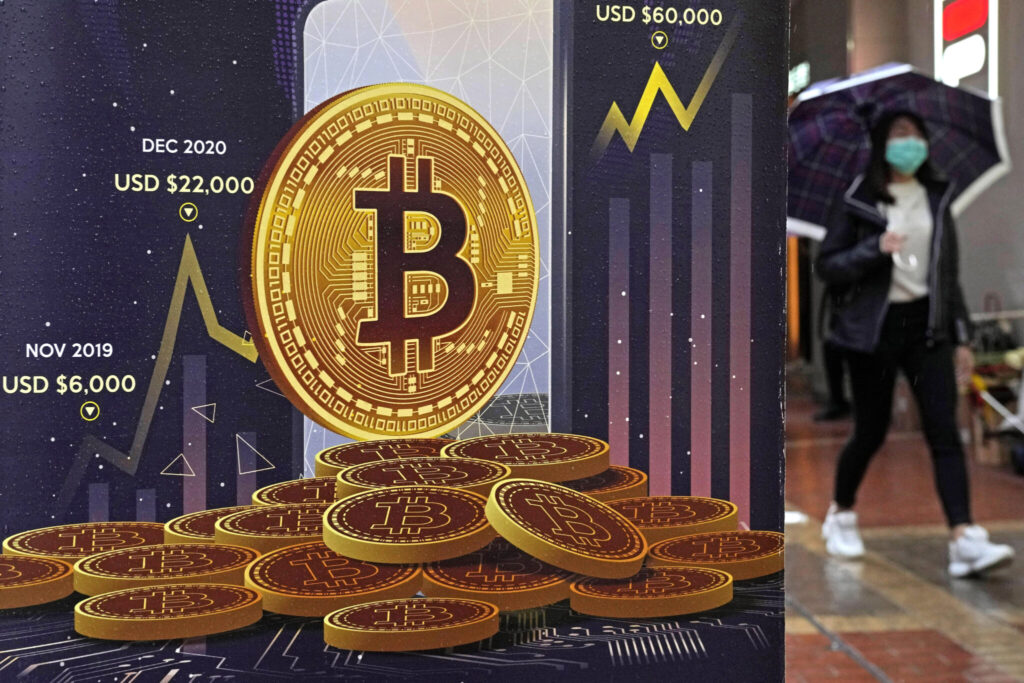Bitcoin has hit an all-time high less than two years after the collapse of the crypto exchange FTX severely damaged faith in digital currencies and sent prices plunging. The world’s largest cryptocurrency jumped 4% this week and briefly surpassed $68,800 Tuesday, according to CoinMarketCap. That’s just above bitcoin’s previous record set back in November 2021.
Quick Read
- Bitcoin reached a new all-time high, surpassing $68,800, less than two years after the FTX collapse caused a significant dip in cryptocurrency confidence.
- The surge to over 200% from last year is attributed to the U.S. approval of bitcoin exchange-traded funds (ETFs) and the upcoming bitcoin “halving” event expected in April, which reduces the rate of new bitcoin creation.
- The U.S. Securities and Exchange Commission approved the first spot bitcoin ETFs, holding actual bitcoin, a significant step for broader investor access to cryptocurrencies.
- Bitcoin ETFs have seen substantial inflows, with record inflows of $1.7 billion last week, totaling $7.5 billion since their launch in January.
- The anticipated bitcoin halving event, reducing the reward for mining and new coin creation, aligns with increased demand but also raises concerns about potential volatility and price fluctuations.
- Bitcoin’s history of dramatic value swings, including a peak of nearly $69,000 in November 2021 followed by a significant crash, underscores the cryptocurrency’s unpredictable nature and investment risks.
- Despite recent gains, experts caution about the volatile nature of the crypto market and advise cautious optimism for investors navigating the digital finance ecosystem.
The Associated Press has the story:
Bitcoin bounces to an all-time high less than 2 years after FTX scandal clobbered crypto
Newslooks- NEW YORK (AP) —
Bitcoin has hit an all-time high less than two years after the collapse of the crypto exchange FTX severely damaged faith in digital currencies and sent prices plunging.
The world’s largest cryptocurrency jumped 4% this week and briefly surpassed $68,800 Tuesday, according to CoinMarketCap. That’s just above bitcoin’s previous record set back in November 2021.
Then the volatile asset dipped 4%, standing at just over $65,000 but the price is still up almost 200% from one year ago after a meteoric rise.

Gains in recent months have been fueled by the anticipation and eventual U.S. approval of bitcoin exchange traded funds earlier this year, which provided access to a much broader class of investors. The price for bitcoin has surged about 60% since the approval of bitcoin ETFs in January, an easy way to invest in assets or a group of assets — like gold, junk bonds or bitcoins — without having to directly buy the assets themselves.
Also driving prices is what is known as bitcoin “halving” which is anticipated in April. Halvings trim the rate at which new coins are mined and created, thus lowering the supply.
Here’s what you need to know.
EARLY SUCCESS OF BITCOIN SPOT ETFS
In January, the U.S. Securities and Exchange Commission approved the first spot bitcoin ETFs from asset managers including Blackrock, Invesco and Fidelity. These newly-approved ETFs hold actual bitcoin — unlike previous bitcoin-related ETFs that were invested in contracts related to future price bets, but not on the cryptocurrency itself.
While regulators have pointed to persisting risks and maintained reluctance around January’s decision, the greenlight marked a major win the crypto industry.
Institutional demand for bitcoin show “no signs of slowing down,” H.C. Wainwright’s Mike Colonnese and Dylan Scales wrote Tuesday — adding that bitcoin’s popularity “is likely to accelerate in the coming months as more wealth management platforms make spot (bitcoin) ETFs accessible to their clients.”
Using data from crypto platform BitMEX, Colonnese and Scales estimated that the ten bitcoin ETFs averaged $302 million in net daily inflows for the month of February. Last week alone, these spot ETFs booked record inflows of $1.7 billion — bringing total net inflows to $7.5 billion since their Jan. 11 launch.
HALVING ON THE HORIZON
Increased demand is also aligning with bitcoin’s next halving event, which is expected at the end of April.
Bitcoin halving, which occurs every four years, is when the reward for bitcoin mining is cut in half. This reduces how fast new coins are created — making supply more scarce.
While analysts say that constrained supply in a time of high demand can push bitocin’s price higher over time, others point to significant volatility that has resulted before and after halving events — and the possibility of sizable declines.
“Past history may not be a reliable guide to predict how the upcoming halving of bitcoin will influence its value,” Rajeev Bamra, SVP of digital finance at Moody’s Investors Service, noted. “Various external factors, market sentiment shifts, and regulatory developments can influence the trajectory of Bitcoin’s price.”
A HISTORY OF VOLATILITY
Bitcoin has a history of drastic swings in value — which can come suddenly and happen over the weekend or overnight in trading that continues at all hours, every day.
Bitcoin rocketed from just over $5,000 at the start of the pandemic to its November 2021 peak of nearly $69,000, in a period marked by a surge in demand for technology products. Prices crashed during an aggressive series of Federal Reserve rate hikes intended to cool inflation, slow money flows and make risky investments potentially riskier. Then came the 2022 collapse of FTX, which left a significant scar on confidence in crypto.
At the start of last year, a single bitcoin could be had for less than $17,000. Investors, however, began returning in large numbers as inflation started to cool. And 2023’s collapse of prominent tech-focused banks actually led more investors to turn to crypto as they bailed out of positions in Silicon Valley start-ups and other risky bets.
Despite the recent excitement around bitcoin, experts still maintain that crypto is a risky bet with wildly unpredictable fluctuations in value. In short, investors can lose money as quickly as they make it.
“It’s essential to exercise caution and acknowledge that the road ahead for the digital finance ecosystem, particularly the crypto markets, is expected to navigate through a period marked by volatility,” Bamra noted — pointing the importance of “cautious optimism.”







